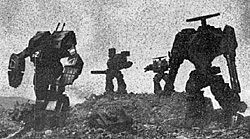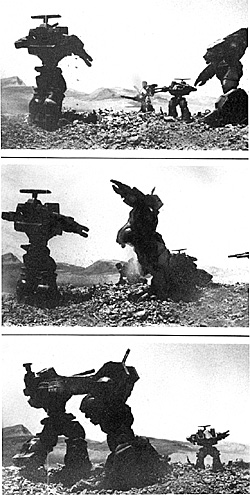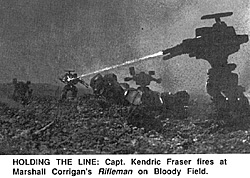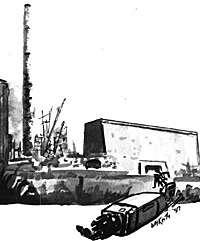 July 5th 6th, 3027 (TC), Corella (Corella II)
July 5th 6th, 3027 (TC), Corella (Corella II)
Black Douglas Forward: Command Lance, Company C, 1st Battalion, Scotian Highlanders, advances to the front at Kilgour.
BattleTechnology recognizes the fact that many of its readers are either MechWarriors themselves or are keenly interested in the the topic of BattleMech strategy and tactics. As a special service to these readers, the editorial staff at Battle Technology is pleased to offer this continuing series of in-depth examinations of battlefield tactics as applied in various battles, both through history and during modem-day BattleMech campaigns.
The first battle to be examined in this series is the Battle of Kilgour, the culmination of a recent Liao raid into Davion space which is still unresolved. Due to the time lag necessary for information to cross the gulf between stars, news of Kilgour was received at Battle Technology's editorial offices on Exeter only three days before this issue went to press. We are still awaiting the final word on the outcome of the campaign.
Battle of Kilgour
July 5th - 6th, 3027 (TC), Corella (Corella 11)
BACKGROUND
Corella is a K1 star currently lying within the borders of the Federated Suns but formerly belonging to House Liao. Its second planet, also called Corella, is primarily an agricultural world. It shows the usual mix of terrain features common to terrestrial planets throughout the Inner Sphere, with somewhat smaller oceans and markedly larger deserts than are known to Earth.
The steppes of Corella's vast, southern continent are, for all intents and purposes, a single vast prairie of mutated wheat of Terran stock, imported during the early Exodus Period of stellar exploration and colonization some seven hundred years ago.
Besides being a significant source of food production, Corella occupies an important position in the network of starlanes through the region. For this reason, it assumed a special importance during the commencement of Operation: Galahad, the round of maneuvers and wargames scheduled to begin on August 22, 3027. Elements of Davion's fleets moving into position for Galahad's maneuvers at Hadnall and Mentasta were deployed through the Corella system.
Wargames and practice maneuvers are not a new phenomenon in this region (see: What Is Hanse Up To? on page 16). For months, Liao's agents had been aware of the increased military traffic in the area, and it was assumed by the Liao Staff Command 'that these maneuvers were similar to those held at this time last year. There is always the chance, however, that practice maneuvers are in fact a cover for full-fledged mobilization and the precursor to an all-out attack. Late in June, Maximilian Liao decided to stage an intelligence raid on Corella, with the purpose of determining the true nature of Davion's maneuvers.
Timed by a meticulous analysis of undercover agents' reports from various systems throughout the Capellan March, Liao's strike arrived at Corella between major passages of JumpShip convoys. Both JumpPoints were empty, and the only defending forces on the planet were the local militia and the Scotian Highlanders, a single, understrength regiment of mercenaries in the pay of House Davion. Advance elements of Liao Special Forces grounded at the Corellan spaceport, seizing that facility, as well as the Highlanders' grounded DropShips. Two battalions of Liao BattleMechs then set down at the spaceport and deployed to face the local forces. The Liao commander's goal was to secure MechWarrior prisoners for interrogation. The defender's goal was to blunt the Liao attack and recapture the spaceport if possible.
By a coincidence of history and tradition, the principal forces on both sides of the engagement were Highlanders, each claiming descent from Scots colonists from Old Earth. Liao's forces were the Second and Third Battalions of the 2nd Kearny Highlanders, a regiment organized as part of the well-known Northwind Highlanders in Liao's service. The Keamys are a veteran unit, blooded in numerous engagements along the Capellan Confederation's frontiers. The Scotians, originally raised on Caledonia, have a long and distinguished history of service first to Steiner and later to Davion. With Scots pride as well as military necessity on the line, the engagement was certain to be a bloody one.
Prelude to Battle
Kilgour is an unremarkable village located in the foothills of the Aphalsia Mountains south of Port Corella. Its single distinguishing characteristic is its position at the hub of a road nexus joining Port Corella and other coastal communities with the cities and grain depots in the steppelands south of the mountains.
Kilgour became a battlefield when reconnaissance elements of the 2nd Kearny Highlanders clashed with the rear guard (the Scotian Highlanders north of town). Each side thought that they had encountered a small detachment of the opposing force; both sides responded to the initial skirmish by rushing large numbers of troops and BattleMechs towards Kilgour in an attempt to trap what was perceived as a isolated enemy unit. For Major Martell Longheart of the Kearny's Second Battalion, this was a golden opportunity to capture prisoners and gain the intelligence Liao had demanded.
For Colonel Ramsay Graham of the Scotians, this was an opportunity to defeat a superior force in detail. Like so many other battles throughout history, Kilgour was a bloody accident.
OPPOSING STRATEGIES
The encounter of July 5th was a complete and lightning-swift series of clash and counter clash which began north of town and carried through the streets of Kilgour itself until much of the town was reduced to rubble. By the time Major Longheart arrived on the field late in the afternoon of July 5th, the Scotian Highlanders had managed to form a strong defensive position along a chain of ridges--Sumner's Ridge Venable's Ridge, Greirson's Hill, Gray Top--south of Kilgore's ruins.
Judging his own forces to be superior to those of the enemy, Longheart ordered a general advance against the Scotian positions. Colonel Graham was well aware of his own inferior numbers in the contest. Having expected to find a light recon company in Kilgour when he deployed the main body of his army, he found instead almost two full battalions, and himself heavily outclassed both in numbers and in total 'Mech tonnage. Weighing his chances, he saw essentially two possible plans open to him.
The safest course would be to hold his position on the heights south of town, trusting in his advantage of position and defense to tell in the attack he was certain would come. Most of his advisors recommended this course of action.
The second course was far riskier but carried with it the possibility not only of holding against superior numbers, but of decisively defeating Longheart's force. By allowing his center to abandon its carefully prepared position along Sumner's Ridge and retreat in apparent disorder, he hoped to tempt the 2nd Kearny Highlanders into a general advance against his center. His flanks, secretly strengthened by units redeployed from his center and camouflaged in the woods north and south of Sumner's Ridge, would hold their positions. The Davion line would be allowed to bend back until it assumed a huge horseshoe shape anchored on the wooded hilltops flanking Sumner's Ridge. When the Liao forces were fully committed in the pocket between Graham's flanks, a signal from Graham, two red rockets, would order the flanking unitsto fall on Longheart's 'Mechs from the sides and rear.
This plan, based somewhat on the tactics used successfully by Hannibal at the ancient Battle of Cannae during Earth's prespaceflight era, could give Graham the edge he needed, allowing him to concentrate his firepower against a tightly-packed and relatively slow-moving enemy to best effect.
After careful consideration, Graham elected to ignore his staff's advice, and prepared to adopt the more mobile--and dangerous--defense.
The Battle of Kilgour, Second Day, July 6th, 3027
 The Kearny's Third Battalion opened the second day's action at 0530 (TST) with a
general advance against the Scotian's central positions along Sumner's Ridge.
The Kearny's Third Battalion opened the second day's action at 0530 (TST) with a
general advance against the Scotian's central positions along Sumner's Ridge.
Right (top to bottom): MECH-TO-MECH: Lt. Heather Fife's Archer, Command Lance, Company C, (Black Douglas) takes a Kearny Rifleman from the flank on Bloody Field.
According to plan, the Scotians held their position for nearly two hours and forty minutes under a fierce bombardment, then began a slow and deliberate withdrawal back down the reverse slope of the ridge. By 1015 hours, the Scotian Highlanders had fallen back nearly a kilometer to an area labelled "Bloody Field" in Graham's field report.
Longheart's battalion, meanwhile, had occupied Sumner's Ridge and was in a position from which they could sweep the far slope of the ridge with heavy fire. This was the critical point in Graham's battle plan. If Longheart remained where he was, he would retain an unassailable position--the same position, in fact, which Graham had only recently held himself!
With Longheart positioned squarely between Graham's flanks but unwilling to advance into the trap, Graham would have no choice but to break off the engagement, a move which was certain to result in serious losses to his flanks and to his already badly mauled center.
Graham was counting, however, on Longheart scenting victory in the wind and ordering an all-out attack.
At 1145 hours, Longheart completed minor repairs to several of his heavy 'Mechs, redeployed his infantry forward, and ordered the Third Battalion to advance. The Second Battalion he held in reserve; he knew Davion forces of unknown strength were still holding the heights north and south of Sumner's Ridge and wanted a reserve which could deal with these units, if necessary. Graham's center, however, beckoned him on down the east slope of the ridge. With numerous 'Mechs already badly damaged, with Graham's lance formation in visible disarray, the possibility of crushing Graham's force once and for all proved irresistible. One final blow would fragment the Davion mercenaries, leaving them helpless.
The engagement in Bloody Field was a furious, seesaw affair. Graham's forces surprised Longheart's MechWarriors with the savage determination of their defense. The cluster of buildings which marked the Sumner Farm changed hands seven times in less than two hours; it was burned to the ground during the exchange. Graham, hoping to draw Longheart's reserve battalion into the fray, stubbornly refused to give the signal which would unleash his flank assault.
At 1400 hours, as the battle in the Bloody Field continued, Liao infantry platoons scouting the hills north of Sumner's Ridge encountered hidden Davion 'Mechs, and a sharp firefight ensued. Two Graham infantry platoons supported by armed skimmers broke the Liao attack, but it was feared that the nature of the waiting trap had been discovered.
The location of numerous BattleMechs in the woods north of Sumner's Ridge was reported to Major Longheart, but the Liao commander did not act on the information. Perhaps he thought the reports exaggerated. Perhaps he feared a Davion ruse. It is possible that the threat of additional fresh forces on the Davion flank made him withhold his reserves at a critical moment, rather than throw them into the battle. It is impossible at this point to guess whether the Second Battalion's arrival on the field would have allowed Graham to victoriously close his trap on the entire Liao force overwhelmed the Davion defenders that Graham's line would have been fragmented and the survivors hunted down piecemeal.
As the battle continued, Graham's center came perilously close to breaking. Numerous lances were down to a single 'Mech apiece and were absorbed into other lances, and at least three companies had dissolved completely, all of their 'Mechs destroyed, crippled and abandoned, or hopelessly lost in the murky field of battle. At one point with the Davion line giving way, a Company of the Scotian's First Battalion, Randall's Raiders, hurled themselves against an attacking column of least twice their own tonnage in 'Mechs. Their valiant charge momentarily swept the field of Liao machines but left the Raiders with only four badly damaged 'Mechs still in action. Dozens of 'Mechs on both sides were forced to withdraw temporarily as their heat built to dangerous levels. Several 'Mechs were forced to shut down as their power systems overloaded, freezing them helplessly in place.
At last, Graham could wait no longer. B Company of Macarron's 'Mechs, half its BattleMechs out of the fight, was falling towards the rear, and the entire Davion center wavered, close to collapse. Graham gave the order which fired two red rockets.
 HOLDING THE LINE: Capt. Kendric Fraser fires at Marshall Corrigan's Rifleman on Bloody Field.
HOLDING THE LINE: Capt. Kendric Fraser fires at Marshall Corrigan's Rifleman on Bloody Field.
Both flank elements had been waiting for the signal, fearful that something had gone wrong, wondering whether to join their comrades or continue to obey orders. Screening forces were thrown south along Sumner's Ridge to keep an eye on the enemy Second Battalion, while the body of the Davion reserves streamed into the Third Battalion's rear and flanks in a full-tilt charge.
The culmination of Graham's plan was a success, though not the total victory for which he had hoped. The 2nd Kearny Highlanders were already as badly bloodied as the Graham center, and the appearance on the field of large numbers of fresh and undamaged 'Mechs was enough to turn the tide of battle with unexpected suddenness.
As Graham had planned, the Liao 'Mechs were badly positioned, so tightly grouped that many of their number were unable to fire for fear of hitting their own comrades. After another five minutes of raw and furious carnage, the Kearny's Third Battalion broke, its survivors streaming west up the slope of Sumner Ridge. Graham forces occupying the ridge stepped aside and let them pass, too heavily outnumbered to more than slow the Kearny Highlanders' passing. The Second Battalion advanced in a general demonstration against the Davion line, but the retreat of the Third Battalion seemed to have unnerved the entire Liao force.
Once the last of the Third Battalion's survivors were back across Sumner's Ridge, the Liao force pulled back to the relative security of its former positions. The battle ended at 1730 hours, with both armies occupying roughly the same positions as they had twelve hours before.
AFTERMATH
 Major Longheart still outnumbered his Davion opponent by a considerable margin, especially considering the fact that Graham's forces had been roughly handled in the back-and-forth slugfest in Bloody Field. Numerous critics have been quick to point out that another hard shove by the
Kearny Highlanders on July 7 would have broken the back of the Davion line and ended resistance on the planet immediately.
Major Longheart still outnumbered his Davion opponent by a considerable margin, especially considering the fact that Graham's forces had been roughly handled in the back-and-forth slugfest in Bloody Field. Numerous critics have been quick to point out that another hard shove by the
Kearny Highlanders on July 7 would have broken the back of the Davion line and ended resistance on the planet immediately.
But Longheart could not know what reserves Graham might have, or how badly damaged his partial regiment might be. Besides, he had captured numerous prisoners during the previous, bloody two days and so had technically fulfilled the letter of his operational orders. On July 7, the two armies remained in place, watching one another warily. During the night, Longheart gave the order to withdraw, and the Kearny Highlanders began wending their way north towards Port Corella.
It is yet too early to assess the final effect the Battle of Kilgour will have on the Corellian Campaign. As of the last reports available in Exeter--dated July 29th--the 2nd Kearny Highlanders continued to occupy a static defense perimeter around Port Corella, while Graham's Scotian Highlanders continued to threaten the port and block Liao movements towards the continental interior. Reinforcements on either side would be certain to tip the balance heavily towards one side or the other, but the command staffs on both sides seem content to wait and watch, at least for now.
Clearly, Kilgour was a major victory for Corella's Davion defenders. The Liao forces on Corella abandoned the field of battle and, more, abandoned the initiative, withdrawing to fixed positions under what amounts to a state of siege.
More importantly from a tactical point of view, however, Kilgour is a clear demonstration of the age-old axiom that no plan survives contact with the enemy, that even the most daring, best laid or most foolproof plan will not unfold in the manner envisioned by its creators. Even with the art of warfare honed by centuries of continuous bloodshed into a study with all the keen precision of any science, modern combat remains a discipline more subject to chance than to design.
Back to BattleTechnology Table of Contents
Back to BattleTechnology List of Issues
Back to MagWeb Magazine List
© Copyright 1987 by Pacific Rim Publishing.
This article appears in MagWeb (Magazine Web) on the Internet World Wide Web.
Other military history articles and gaming articles are available at http://www.magweb.com